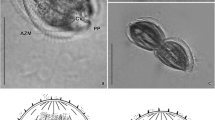Summary
Before formation of the cyst wall, the food vacuoles are lost, the cell rounds up and the flagella lie close against the body in a flagellar groove. At this early stage, the contractile vacuole is very active, the Golgi apparatus is prominent and the basophilic cytoplasm is composed of closely packed ribosomes. As the cyst wall is secreted, layer by layer, the large Golgi apparatus is replaced by several smaller membrane stacks and mitochondrial changes occur involving local loss and modification of the cristae. Some parts of the mitochondrion undergo degenerative changes and may become surrounded by bacilliform bodies. These same bodies are also associated with small particles of sequestered cytoplasm which are present throughout the encystment process and are believed to be autophagic vacuoles. As the cyst wall thickens, cell shrinkage is manifest as a number of membrane invaginations. The final cyst wall is of uneven thickness and possesses a single operculum which is visible only by electron microscopy. Probable cyst wall precursor is found in small vesicles scattered throughout the cytoplasm.
Similar content being viewed by others
References
Band, R. N., 1963: Extrinsic requirements for encystation by the soil amoebaHartmanella rhysodes. J. Protozool.10, 101–106.
Bowers, B., andE. D. Korn, 1969: The fine structure ofAcantbamoeba castellani (Neff strain). II. Encystment. J. Cell Biol.41, 786–805.
Brooker, B. E., 1971 a: The fine structure ofBodo saltans andBodo caudatus (Zoomastigophora: Protozoa) and their affinities with theTrypanosomatidae. Bull. Br. Mus. nat. Hist.23, 87–102.
—, 1971 b: The fine structure ofCrithidia fasciculata with special reference to the organelles involved in the ingestion and digestion of protein. Z. Zellforsch.116, 532–563.
Duve, C. de, andP. Baudhuin, 1966: Peroxisomes (microbodies and related particles). Physiol. Rev.46, 323–357.
—, andR. Wattiaux, 1966: Functions of lysosomes. A. Rev. Physiol.28, 435–492.
Dobell, C., andF. W. O'Connor, 1921: The intestinal protozoa of man. London: J. Bale, Sons and Danielsson.
Elliott, A. M., andI. J. Bak, 1964: The fate of mitochondria during aging inTetrahymena pyriformis. J. Cell Biol.20, 113–129.
Graves, L. B., L. Hanzely, andR. N. Trelease, 1971: The occurrence and fine structural characterization of microbodies inEuglena gracilis. Protoplasma72, 141–152.
Griffiths, A. J., D.Lloyd, G. I.Roach, and D. E.Hughes, 1967: Metabolic changes inHartmanella castellani during encystment., Biochem. J.103, 21 P.
Hollande, A., 1942: Étude cytologique et biologique de quelques flagellés libres. Arch. Zool. exp. gén.83, 1–268.
Kühn, A., 1915: Über Bau, Teilung und Encystierung vonBodo edax Klebs. Arch. Protistenk.35, 212–255.
Müller, M., 1969: Peroxisomes of protozoa. Ann. N.Y. Acad. Sci.168, 292–301.
—, andK. M. Møller, 1967: Peroxisomes inAcanthamoeba sp. J. Protozool.14, (Suppl.) 11–12.
Robertson, M., 1929: The action of acriflavine uponBodo caudatus. Parasitology21, 375–416.
Rudzinska, M., P. A. D'Alesandro, andW. Trager, 1964: The fine structure ofLeishmania donovani and the role of the kinetoplast in the leishmania-leptomonad transformation. J. Protozool.11, 166–191.
Ryley, J. F., 1966: Histochemical studies on blood and culture forms ofTrypanosoma rhodesiense. Proc. 1st Int. Congr. Parasit.1, 41–42.
Sinton, J. A., 1912: Some observations on the morphology and biology ofProwazekia urinaria (Bodo urinarius, Hassall). Ann. trop. Med. Parasit.6, 245–269.
Swift, H., andZ. Hruban, 1964: Focal degradation as a biological process. Fed. Proc.23, 1026–1037.
Vickerman, K., 1960: Structural changes in mitochondria ofAcanthamoeba at encystation. Nature (Lond.)188, 248–249.
—, 1962 a: Patterns of cellular organization inLimax amoebae. Exp. Cell Res.26, 497–519.
—, 1962 b: The mechanism of cyclical development in trypanosomes of theTrypanosoma brucei sub-group: An hypothesis based on ultrastructural observations. Trans. R. Soc. trop. Med. Hyg.56, 487–495.
- 1971: Morphological and physiological considerations of extracellular blood protozoa. In: Ecology and physiology of parasites (ed. A. M.Fallis), pp. 58–91. University of Toronto Press.
Woodcock, H. M., 1916: Observations on coprozoic flagellates: together with a suggestion as to the significance of the kinetonucleus in the binucleata. Phil. Trans. R. Soc. (B)207, 375–412.
Author information
Authors and Affiliations
Rights and permissions
About this article
Cite this article
Brooker, B.E., Ogden, C.G. Encystment ofBodo caudatus . Protoplasma 74, 397–409 (1972). https://doi.org/10.1007/BF01281958
Received:
Issue Date:
DOI: https://doi.org/10.1007/BF01281958




